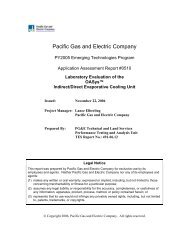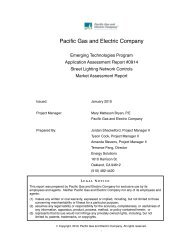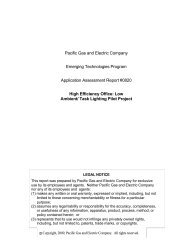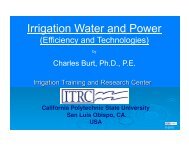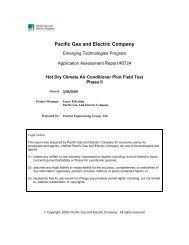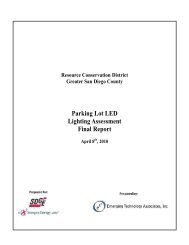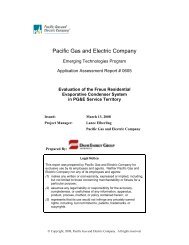Download the project report.
Download the project report.
Download the project report.
You also want an ePaper? Increase the reach of your titles
YUMPU automatically turns print PDFs into web optimized ePapers that Google loves.
to bring <strong>the</strong> tank back to temperature, and after cut-out <strong>the</strong> cycle is repeated, if <strong>the</strong> time is less<br />
than one hour from <strong>the</strong> start of <strong>the</strong> first draw. At <strong>the</strong> end of one hour, if a draw is occurring it is<br />
allowed to finish according to <strong>the</strong> previous criteria. If a draw is not occurring, one is started and<br />
allowed to continue until <strong>the</strong> outlet temperature reaches <strong>the</strong> shut-off temperature from <strong>the</strong><br />
previous draw. The first hour rating is <strong>the</strong> total volume of water released from <strong>the</strong> start of <strong>the</strong><br />
first draw.<br />
• Energy Factor is <strong>the</strong> result of a 24-hour simulated use test beginning immediately after <strong>the</strong> water<br />
heater is fully heated (burner cut-out after drawing enough to activate it). It divides a total draw<br />
of 64.3 gallons of hot water into six draws each an hour apart, with <strong>the</strong> remainder of <strong>the</strong> 24-hours<br />
with <strong>the</strong> unit in standby. The Energy Factor is <strong>the</strong> energy in <strong>the</strong> hot water delivered with a 77°F<br />
temperature rise divided by <strong>the</strong> total energy consumed in <strong>the</strong> 24-hours. The calculation of <strong>the</strong><br />
factor includes adjustments for off-standard test conditions and for <strong>the</strong> change in stored energy in<br />
<strong>the</strong> tank as <strong>the</strong> result of starting and ending <strong>the</strong> test at different average tank temperatures.<br />
• Recovery Efficiency is based on <strong>the</strong> ratio of <strong>the</strong> energy contained in <strong>the</strong> first 10.7-gallon draw in<br />
<strong>the</strong> Energy Factor test divided by <strong>the</strong> energy consumed to bring <strong>the</strong> tank back to <strong>the</strong> fully heated<br />
state (burner cut-out). Standby losses are a minor component of this factor because of <strong>the</strong><br />
relatively short duration.<br />
The data acquisition and control computer was programmed to conduct tests automatically according to a<br />
script. At <strong>the</strong> start of a draw event, a bypass valve was opened at <strong>the</strong> end of <strong>the</strong> heater supply header, and<br />
<strong>the</strong> mixing valve was controlled to precondition <strong>the</strong> header to <strong>the</strong> proper water temperature. Once <strong>the</strong><br />
temperature criteria was satisfied at <strong>the</strong> bypass valve, <strong>the</strong> test heaters were activated in sequence starting<br />
from <strong>the</strong> unit closest to <strong>the</strong> bypass valve and working back along <strong>the</strong> supply header towards <strong>the</strong> tempering<br />
valve to ensure a consistent supply temperature.<br />
RESULTS<br />
Test Units<br />
There are very few commercial HPWH products on <strong>the</strong> market, but more are proposed. This first round<br />
was limited to two models with distinct differences in <strong>the</strong>ir design. The first unit listed is not a packaged<br />
HPWH, but is an add-on for existing electric water heaters. As such, it required <strong>the</strong> purchase of a<br />
separate electric water heater. While <strong>the</strong> DOE standard requires a 47-gallon tank, one of this capacity<br />
could not be located. The test tank was larger at 55-gallons, and had 3.8 kW elements ra<strong>the</strong>r than <strong>the</strong><br />
required 4.5 kW. In keeping with <strong>the</strong> manufacturer’s recommendation, <strong>the</strong> lower heating element was<br />
disabled, and <strong>the</strong> upper heating element would only activate if <strong>the</strong>re was enough cold water in <strong>the</strong> tank to<br />
activate <strong>the</strong> upper <strong>the</strong>rmostat.<br />
Table 3 below contains a summary of <strong>the</strong> specifications for <strong>the</strong> test units (including <strong>the</strong> electric water<br />
heater for <strong>the</strong> add-on unit), and Table 4 contains a listing of <strong>the</strong>ir rated performance characteristics.<br />
Following <strong>the</strong> tables are detailed descriptions of each water heater.<br />
Manufacturer Product Line Model Number<br />
AirGenerate AirTap A7<br />
Kenmore PowerMiser 6 153.3265562<br />
Rheem HP50 JP4A-A050510<br />
Table 3: Summary of Test Units<br />
491-09.17.doc 12<br />
Product<br />
Description<br />
Add-On<br />
Immersion<br />
Electric<br />
Resistance<br />
Combination<br />
Pump Circulation<br />
Tank<br />
Capacity<br />
(gallons)<br />
Dimensions<br />
(inches)<br />
Refrigerant<br />
- R-22<br />
55<br />
50<br />
60¼ H ×<br />
20½ Dia<br />
75½ H ×<br />
21 Dia<br />
-<br />
R-410a



